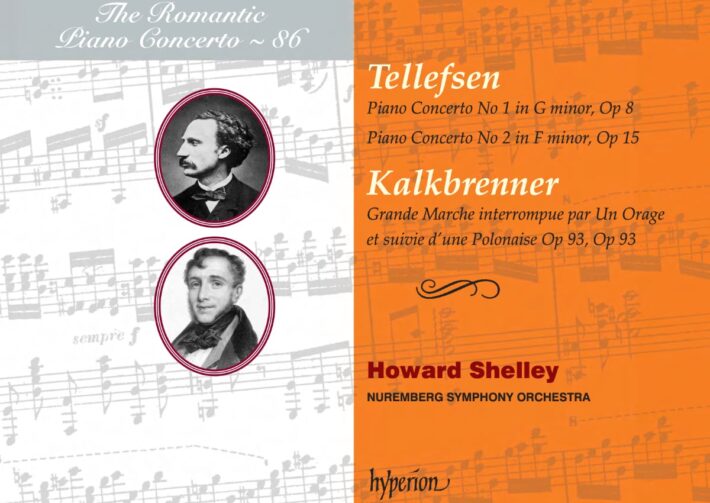Hyperion’s exhaustive exploration of Romantic Piano Concertos continues with this newest release, volume 86 in the series. Since both composers are likely new to many readers, a brief biography seems in order.
Born the youngest of six siblings in 1823, Thomas Tellefsen’s first music lessons were with his father, Johan Christian Tellefsen, organist of Trondheim Cathedral. In his late teens he traveled to Paris, where he became a friend and occasional pupil of Frederic Chopin. In April 1851 Tellefsen made his Paris debut, and a newspaper report of the concert reports he was a “faithful admirer of Chopin…imbued with his [Chopin] spirit and with whom he felt close affinities of sentiment.” Indeed, both concertos (especially the second) have several moments of sweet melancholy and self-effacing virtuosity that are Chopinesque.
Despite these momentary similarities, Tellefsen has his own, conservative voice. Both concertos follow the classical three movement form, with an opening movement in Sonata form, the piano first entering with the repeat of the exposition. The final movements of both works use folk material: the first uses a Norwegian bridal march (one also used by Grieg and Svendsen); the second uses a tarantella.
Tellefsen does not seek to break rules. The solo part does not struggle against the orchestra and his harmonic language will seem conservative when compared to Schumann’s concerto (1845) and Liszt’s first concerto (1849 – Tellefsen’s concertos were around this same time). But the solo part offers many opportunities for virtuosic display, complimented by thoughtfully crafted orchestration and fetching melodic lyricism.
Related Posts
- Review: Chopin – Rafał Blechacz, Piano
- Review: Liszt – Piano Concertos, Sonata – Alexander Ullman, BBC Symphony, Litton
- Review: Saint-Saëns – Piano Concertos Nos. 1 & 2 – Alexandre Kantorow
These concertos have been recorded once before, by pianist Einar Steen-Nøkleberg and the Trondheim Symphony under Terje Mikkelsen (Simax). It has been fascinating to compare the two recordings: in the opening of the first concerto, the Nuremberg orchestra is clean and precise, but Mikkelsen and his Trondheim players uncover more detail and color. The sound in Nuremberg is string focused, whereas the earlier release allows for greater wind detail. While the Nuremberg players seem to respect the music, the Trondheim seems to really believe in it, giving their accompaniment a more compelling level of imagination.
Shelley’s initial entrance is perfectly balanced, weightier and darker than Steen-Nøkleberg’s performance – this holds true throughout. Shelley is also generally faster, making the challenging passages more overtly showy, whereas Steen-Nøkleberg’s lighter approach has a more delicate filigree. Different approaches, but both prove satisfying.
Things are more even in the second concerto. While more cut and thrust in the opening movement would not go amiss, the second movement Adagio offers playing of refined beauty, its middle section finding a rapt intimacy as the piano accompanies beguiling solo work from the Nuremburg winds. The final movement, played faster than in Trondheim, has an infectious energy that would certainly bring an audience to its feet if we were fortunate to hear this in a live performance.
While the older Simax recording only has the two concertos, the new Hyperion comes with a substantial addition: Friedrich Kalkbrenner’s 20-minute “Grande Marche.” Kalkbrenner was a well-known pianist, composer, teacher, and piano manufacturer, who left Germany at a youthful age to study at the Conservatoire de Paris, eventually settling in the capital for the remainder of his life. Hyperion has recorded several of his piano concertos in previous entries in this series.
Written for string orchestra and piano, “Grande Marche” is intended as a tour de force display piece, and Shelley is certainly up to the challenge, making light of its every technical demand. While I can imagine enjoying this in concert, after several hearings it did feel like mere note-spinning. Others may find more in it than I do.
Hyperion’s recording is a bit airless compared to the earlier Simax recording – one has the sense that the sound is never allowed to fully bloom. The liner notes, as always with Hyperion are engaging and erudite. Shelley’s playing cannot be faulted – he seems to fully believe in all the repertoire that he plays, and his formidable technique allows him to easily meet every musical challenge. Nevertheless, I find myself preferring the Trondheim recording, in part because of its engineering, and because the orchestral work is more consistently impressive. Both recordings introduce us to concertos that deserve to be far better known.

Tellefsen & Kalkbrenner: Piano Concertos
Nuremberg Symphony Orchestra
Howard Shelley – Piano & Conductor
Hyperion, CDA68345
Recommended Comparisons
Kalkbrenner – Concerto No. 1 – Kann | Kalkbrenner Sonatas – Gerosa | Kalkbrenner Etudes – Hay
Included with an Apple Music subscription:
Read more classical music reviews or visit The Classic Review Amazon store
Follow Us and Comment:
[wd_hustle id=”HustlePostEmbed” type=”embedded”]












